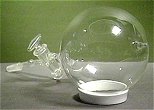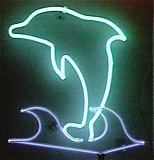 Discovery Information Discovery Information |
| Who:
Sir William Ramsay
,
Baron Rayleigh
|
| When: 1894 |
| Where: Scotland |
|
 Name Origin Name Origin |
| Greek: Argos (inactive). |
|
 Sources Sources |
| Argon makes up 1% of the air and is isolated by removing nitrogen, oxygen, carbon dioxide and water from air. Argon is constantly being formed from the radioactive decay of radioactive potassium-40. |
|
 Uses Uses |
| Argon is used for lighting. It may also be used to provide an inert atmosphere for certain projects when explosion or other forms of oxidation may pose a problem. Also used in "Geiger" counters, which measure
radiation
levels. |
|
 Notes Notes |
| Before 1962, argon and the other noble gases were generally considered to be chemically inert and not able to form compounds. However, since then, scientists have been able to force the heavier noble gases to form compounds. In 2000, the first argon compounds were formed by researchers at the University of Helsinki. By shining ultraviolet light onto frozen argon containing a small amount of hydrogen fluoride, they were able to form argon hydrofluoride (HArF). |
| The Martian atmosphere contains 1.6% of argon-40 and 5 ppm of argon-36. In 2005, the Huygens probe also discovered the presence of Ar-40 on Titan, the largest moon of Saturn. |


 Discovery Information
Discovery Information Name Origin
Name Origin Sources
Sources Uses
Uses Notes
Notes Images
Images
